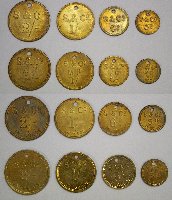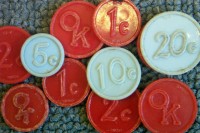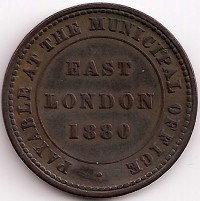
The History and Origin of Token Coins
Description of various types of token coins with the most valuable listed first (ie "Currency tokens")

The word "token" is derived from the Anglo-Saxon "tacen", for a sign or a symbol. Strictly speaking nearly all of the world's present day coinage and bank notes have been "tokens of value" since we came off the gold standard. However, the commonly accepted numismatic definition of a token is a piece of metal or plastic, resembling a coin in shape, size and type but issued privately, usually without Government authority, that is used as a substitute for official coinage; generally as a pledge to be redeemed either in goods to the value it represents or in corresponding coin of the realm. We do not recognise modern or older paper or cardboard advertising discounts or coupons as "tokens".
Sadly, despite the fact that many of the earlier South African tokens were issued in times of acute shortage of official coinage, there seems to be little effort in literature, or research by numismatists, to record or recognise the important role that tokens played in the evolution of this colonial outpost.
Anna H Smith in her Preface to E J Maynard's book on the token coins of the Africana Museum describes tokens thus:
According to the Oxford English Dictionary, a token is "a stamped piece of metal, often having the general appearance of a coin, issued as a medium of exchange by a private person or Company, who engage to take it back at its nominal value, giving goods or legal tender for it". The definition applies to the true token; but there are others which, although not, strictly speaking, substitutes for coins of the realm, are issued by private persons or companies as advertising mediums, bar or bottle tokens, as discounts on purchases, for use in amusement machines, etc. All tokens have an advertisement value.
Each and every token coin has its own unique history, its own small part that it played in its own unique environment. Each and every token represents an unique human endeavour in the realm of business.
Each and every token was seen by the bearer, who accepted it, as valuable and tradable - this is what makes token coins so extraordinary special, yet sadly so overlooked by many numismatists.
 Return to Menu
Return to Menu
There are certain recognisable types of tokens (see below) with the "currency" and the "trade" tokens being the most valued by numismatists. The historical functional use in the community of these two types has resulted in them being highly sought after today. However, the relatively low value of token coins used as currency reflects the stigma often attached to these coins when theses values are compared to the much higher prices paid for official currency. This often is a direct result of poor research or available information on the history of token coins. A very good example of a "currency" token is outlined below - with links to information about that coin - the price of the Strachan and Co tokens have risen dramatically in the last few years but still have a long long way to go before they catch up with the Veld Pond and Burger Pond prices of better researched coins circulated during that chaotic time in South African history.
 Return to Menu
Return to Menu
The "currency" trade token is the most sought after of true trade tokens. Very few token coins have actually been manufactured to serve any purpose other than to be used by clients at that business.
The Strachan and Co trade tokens were clearly "currency" tokens as this well researched article supported by third party references and scans of documents from the time confirm the fact.
The acceptance of the Strachan and Co trade tokens by the wider population in an area the size of the United Kingdom for over 30 years puts these rare coins into the same league as the Burgerspond (1874) and ZAR coinage. The Strachan and Co "currency" tokens are seen below.

More about the Strachan and Co tokens below..... under the heading "Trade Tokens"
 These are bona fide private coins issued by traders in
times of acute shortage of coin of the state to enable trading activities
to proceed. The token is a pledge redeemable in goods or in coin of the state,
i.e. the face value of the coin represents the real value of the official
coinage.
These are bona fide private coins issued by traders in
times of acute shortage of coin of the state to enable trading activities
to proceed. The token is a pledge redeemable in goods or in coin of the state,
i.e. the face value of the coin represents the real value of the official
coinage.
There is no intended element of coercion or inducement for customers to use a particular trade outlet.
The Strachan & Co sets in circulation between 1874 and 1932 - as shown in the top two sets right (S&Co and "MH"), are examples of classic trade tokens. The lower two "IN GOODS" sets are "barter" tokens (see next listing below)
Image right: the finest complete set of Strachan and Co tokens in existence today. All tokens are EF and better.
The Mountain Home set are the rarest set of the Strachan and Co series. Today, a complete set fetches a very high price.
 Return to Menu
Return to Menu
These are issued by a trader in payment for goods (usually agricultural products) with the agreement that they will be redeemed in goods to an equivelant value at the traders own outlets. The transaction is therefore one of barter, with the tokens playing a role of convenience, allowing the seller to receive his goods at a rate and time convenient to himself and the trader to lock the holder of the token coin to his shop.
Trade tokens often change slowly and subtly into barter tokens over time, as evidence by the continued circulation of former trade tokens when the need for their use had passed.

The Strachan & Co "in goods" sets, are examples of barter tokens. They were in circulation from about 1906 to 1932.
The S & Co "old" 1/- piece (shown above) is the rarest token in the Strachan & Co series.
 Return to Menu
Return to Menu
Over the years a business which changed direction or purpose might continue to use their token coins in a manner reflecting these changes.
The very rare F C Larkan tokens, as displayed, played a number of roles in the Umzimkulu /Ixopo area over a period of about 50 years.
When the aluminium pieces were first struck in Durban they were used as trading tokens by Francis Charlotte Larkan the only female trader in this remote area in the 19th century. When she decided to sell her business to Donald Strachan of Strachan & Co she kept the tokens. Her son, Rupert, later used the tokens to pay labourers on his farm near Creighton.
Labourers working for Rupert would take the tokens into local trading stores who had entered into an arrangement with Mr Larkan. Mr Larkan would redeem the tokens through delivery of farm product such as milk.
In 1955 the tokens were thrown down a "long drop" toilet - they were dug up in 1980. Very few tokens escaped this fate which created major blemishes and holes in their aluminium face.
F C Larkan tokens only used in the trading stores are extremely rare - a few sets exist. The only multipurpose F C Larkan tokens (blemished and corroded) are in the Balson Holdings Family Trust.
 Return to Menu
Return to Menu

These are issued to employees to allow them to purchase goods to the equivelant face value from a specified supplier, the tokens to be redeemed when the employee receives his salary.
In South Africa credit tokens were seen as "unfair practices" especially in the manner they were issued to black employees, and generated opposition to tokens in general, leading to their abolition in 1932.
Image right the rare F C Larkan "dual purpose" tokens used by Percy Larkan to pay labour and redeemed by way of goods from specified local stores.
 Return to Menu
Return to Menu
 These are issued by traders to
their employees in payment of part or all of their wages without the option
of the employee to elect payment in official coinage only. By this practice
the trader ensures that his employees obtain at least some of their requirements
from his own outlets, so that he effectively holds a monopoly on these
commodities. Here again, there is often a shift in emphasis and what were
intended as trade or barter tokens have been used in this manner.
These are issued by traders to
their employees in payment of part or all of their wages without the option
of the employee to elect payment in official coinage only. By this practice
the trader ensures that his employees obtain at least some of their requirements
from his own outlets, so that he effectively holds a monopoly on these
commodities. Here again, there is often a shift in emphasis and what were
intended as trade or barter tokens have been used in this manner.
In South Africa credit tokens were seen as "unfair practices' especially in the manner they were issued to black employees, and generated opposition to tokens in general, leading to their abolition in 1932.
Image right the unique Creighton and Dennis monopoly token once used at Creighton, near Ixopo.
 Return to Menu
Return to Menu
These were issued by traders as a discount in cash transactions, and could be used in part or in full payment in later transactions. The purpose was to induce the customer to return to a particular trader for his requirements. Retailer like OK Bazaars issued these staff discount tokens (below) which gave a 10% discount. (ie One Rand would buy One Rand ten cents in the OK Bazaars staff tokens).

 Return to Menu
Return to Menu
Canteen tokens:
These are meal tickets - normally for use by staff. (See image below for
Holiday Inns, Transvaal token coins.)
Prison tokens
They are issued to prisoners for use in prison shops. The purpose is to limit
a prisoner's spending as normal coinage supplied by friends of the prisoner
is useless within the walls of the prison.
Staff tokens
These are issued to staff who are allowed a limited amount of discount buying
from the firm. Instead of keeping accounts on purchases made by staff it
supplies them with tokens at a discount rate. (See OK Bazaars discount
tokens below - exchanged for the staff at a 10% discount ie R1.10
in tokens for each R1 in normal currency)
Commodity tokens
Like milk tokens, these are sold by a supplier of a given commodity to overcome
the problems associated with handling small change. The image below
is a historic water shortage token used in the town of Jagersfontein
- a very dry part of South Africa.
Coupon tokens
These are issued by a supplier of services (eg bus companies) to avoid the
difficulties of handling inconvenient amounts of small change in difficult
circumstances. (Image below: East London Ferry token used in 1800s)

Machine tokens
These are provided by the owner of slot machines which were made to accept
coin sizes incompatible with available coinage. (See image
below)
Tokens are struck in many interesting materials from gold to plastic. Perhaps the most interesting the South African Railways (Cape Town) catering tokens which are made out of bone. (See image below)
 Return to Menu
Return to Menu
Scribbles
Global Web
Builders
Strachan and
Co
Dar-es-Salaam
FijiBure.Com
EmailStaff
thenetpics
thestoryofus
Author
Woman to
Woman